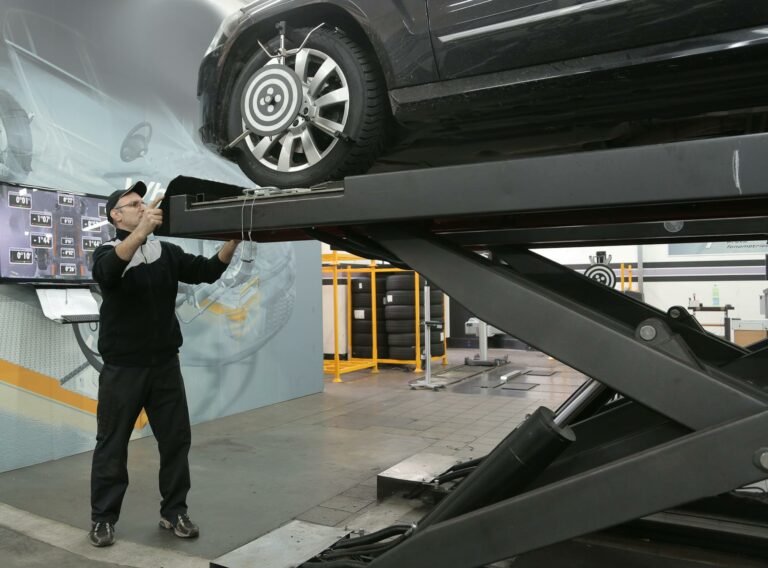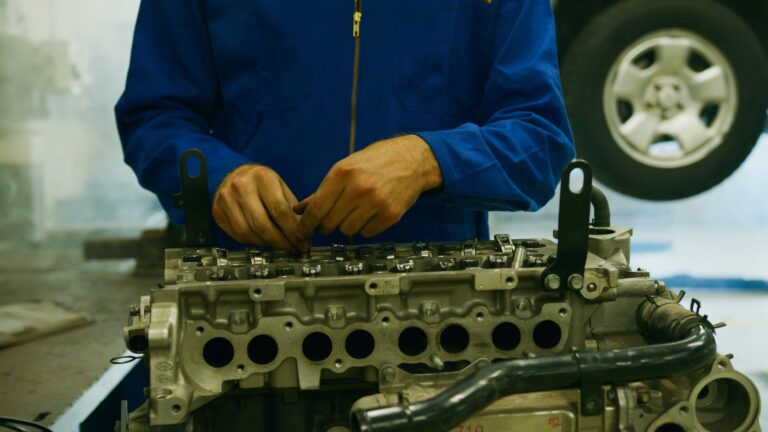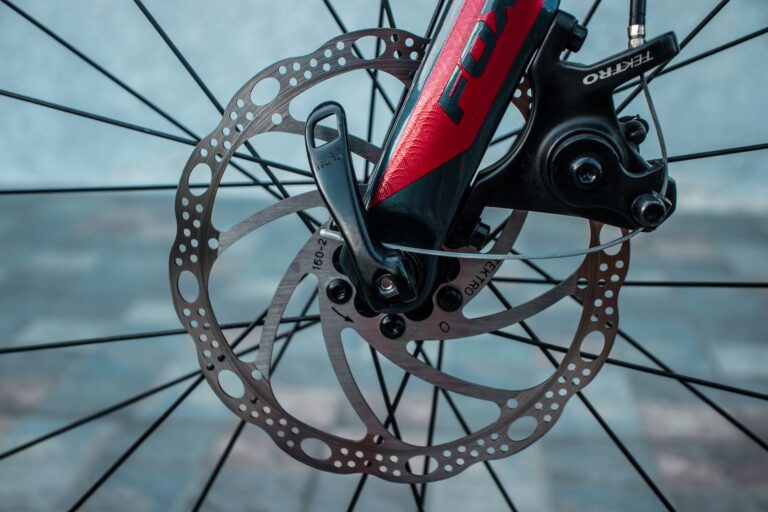Brake Bleeding: What You Need to Know
To ensure the optimal performance and safety of your vehicle’s braking system, it’s crucial to understand the importance of brake bleeding and recognize the signs that your brakes may need bleeding.
The Importance of Brake Bleeding
Brake bleeding is a necessary maintenance procedure for ensuring the proper functioning of the braking system in a vehicle. It involves removing air bubbles from the brake lines to maintain hydraulic pressure and improve brake performance. Air in the brake lines can cause a spongy brake pedal, reduced braking performance, and an increased stopping distance. Therefore, brake bleeding is essential for restoring the responsiveness and effectiveness of the brakes (CarParts.com).
Over time, air and moisture can be introduced into the brake lines, compromising the effectiveness of the brakes and the safety of the driver. This can occur due to factors such as a brake fluid leak, recent brake system repair, or a low brake fluid level. Brake bleeding removes air from the brake line, improving hydraulic pressure and restoring the brake system’s optimal functioning (Mercie J Auto Care).
Signs Your Brakes Need Bleeding
It’s important to be aware of the signs that indicate your brakes may need bleeding. If you notice any of the following symptoms, it’s recommended to have your brakes inspected and consider getting them bled if necessary:
-
Spongy brake pedal: If your brake pedal feels soft or spongy when you press it, this could be an indication of air in the brake lines. When air is present, it compresses more easily than brake fluid, resulting in a spongy brake pedal feel (Autos.com).
-
Reduced braking performance: If you notice that your brakes are not as responsive as they used to be, and it takes longer to bring the vehicle to a stop, it could be a sign of air in the brake lines. Air bubbles can disrupt the smooth flow of brake fluid, reducing the overall effectiveness of the braking system (Autos.com).
-
Increased stopping distance: If you find that your vehicle requires a longer distance to come to a complete stop, it could be due to air in the brake lines. Air bubbles can affect the hydraulic pressure needed to engage the brakes fully, resulting in a compromised stopping distance (Autos.com).
If you experience any of these signs, it is recommended to seek professional brake services, such as brake service near me, to inspect and address the condition of your braking system. A professional mechanic will be able to determine if brake bleeding is necessary and perform the procedure correctly, as brake bleeding requires proper handling and disposal of brake fluid due to its toxicity (Autos.com).
By understanding the importance of brake bleeding and recognizing the signs that your brakes may need bleeding, you can ensure the safety and optimal performance of your vehicle’s braking system. Regular brake maintenance, including brake bleeding, is essential for maintaining the overall effectiveness of your brakes and providing a reliable braking experience when you need it most.
Understanding the Brake Bleeding Process
To maintain the optimal performance of your braking system, it is important to understand the process of brake bleeding. Brake bleeding is a procedure used to remove air bubbles from the brake fluid, ensuring that the brakes function properly and efficiently. When air enters the brake lines, it can cause a spongy or unresponsive brake pedal, compromising your ability to stop safely (Source).
What is Brake Bleeding?
Brake bleeding involves opening the brake bleeder screws on each wheel, allowing the air bubbles to escape along with a small amount of brake fluid. This process is typically performed by two individuals, one to operate the brake pedal and another to open and close the bleeder screws. As the brake pedal is pressed and released, the hydraulic pressure forces the brake fluid and air bubbles out of the system (Source).
Methods for Bleeding Brakes
There are several methods for bleeding brakes, each with its own advantages and suitable applications. Here are some of the commonly used methods:
-
Gravity Bleeding: Gravity bleeding is the simplest method where gravity gradually forces the fluid through the lines and pushes out the air bubbles. To perform gravity bleeding, the brake bleeder screws are opened, and the brake fluid reservoir cap is removed. Over time, the brake fluid flows from the reservoir, down into the brake lines, and out through the open bleeder screws, expelling the air bubbles. This method is best suited for routine maintenance and when there are no severe air pockets in the brake lines (Hagerty).
-
Pressure Bleeding: Pressure bleeding utilizes a specialized tool that pressurizes the brake fluid reservoir. This method forces the brake fluid through the system, pushing out any air bubbles. Pressure bleeding is efficient and effective, especially when dealing with extensive air pockets or when performing a complete brake fluid exchange. It is commonly used in professional repair shops (PowerStop).
-
Vacuum Bleeding: Vacuum bleeding involves using a vacuum pump to draw the brake fluid and air bubbles out of the system. The vacuum pump creates a negative pressure in the brake lines, allowing the fluid to flow from the bleeder screws into a collection container, along with any trapped air. This method is particularly useful for one-person brake bleeding, as it eliminates the need for a second person to operate the brake pedal (PowerStop).
-
Manual Bleeding: Manual bleeding, also known as the pedal pumping method, requires two individuals. One person operates the brake pedal while the other opens and closes the bleeder screws. This method is commonly used and can be effective when performed correctly. However, it may require more time and effort compared to other methods (Source).
When performing brake bleeding, it is important to follow the vehicle manufacturer’s recommended procedure and use the appropriate tools and safety precautions. If you are unsure or uncomfortable with performing brake bleeding yourself, it is recommended to seek professional assistance from a reputable brake repair shop or brake mechanic. They have the expertise and specialized equipment to ensure a thorough and safe brake bleeding process.
Understanding the brake bleeding process empowers you to properly maintain your brake system and ensure your safety on the road. Regular brake bleeding, along with other brake services such as brake pad replacement and brake fluid flush, is essential for optimal brake performance and longevity of your vehicle’s braking system.
When and How Often Should You Bleed Your Brakes?
Proper brake maintenance is essential for the safety and performance of your vehicle’s braking system. Brake bleeding, which involves removing air or moisture from the brake lines, should be performed regularly as part of routine maintenance to maintain the overall performance of the braking system (Source). Let’s explore the recommended brake bleeding frequency and the factors that can affect it.
Recommended Brake Bleeding Frequency
Automotive service experts recommend having your car’s brakes bled every two to three years as part of routine car maintenance (Northeast Auto Service). This interval allows for the removal of any trapped air or moisture that may have accumulated in the brake lines over time. Regular brake bleeding helps maintain the efficiency and safety of the braking system.
Additionally, it is generally recommended to bleed the brakes at least once every two years or as specified in your vehicle’s maintenance schedule. This ensures that the braking system remains in optimal working condition and helps prevent potential issues that may arise from air or moisture buildup (CarParts.com).
Factors Affecting Brake Bleeding Frequency
While the recommended brake bleeding frequency provides a general guideline, there are several factors that can influence how often you should bleed your brakes. These factors include:
-
Driving Conditions: If you frequently drive in extreme or challenging conditions, such as mountainous terrains or heavy traffic, your brakes may experience more stress and heat buildup. In such cases, it may be necessary to bleed your brakes more frequently to maintain optimal performance.
-
Driving Habits: Aggressive driving, which involves frequent and hard braking, can lead to increased wear and tear on your braking system. Bleeding the brakes more often may be necessary for aggressive drivers to ensure proper functionality.
-
Brake Fluid Contamination: Contaminated brake fluid can affect the performance of your braking system. If you suspect that your brake fluid has been contaminated, such as by water or dirt, it is recommended to bleed the brakes as soon as possible to remove any impurities.
-
Brake System Repairs or Modifications: If you have recently performed repairs or modifications on your brake system, such as replacing brake lines or calipers, bleeding the brakes should be done to remove any air introduced during the process.
It’s important to consult your vehicle’s owner’s manual or seek advice from a professional mechanic to determine the specific brake bleeding frequency that is appropriate for your vehicle. They can take into account your driving habits, local climate, and other factors to provide personalized recommendations.
Regular brake bleeding not only ensures the safety and efficiency of your braking system but also helps prevent potential issues such as spongy brakes, reduced braking performance, or brake failure. By following the recommended brake bleeding frequency and considering the factors that can affect it, you can maintain the reliability and effectiveness of your vehicle’s braking system.
Brake Bleeding: DIY or Professional Service?
When it comes to brake bleeding, you have the option to either perform the task yourself or seek professional service. Both approaches have their advantages and considerations. Let’s explore the pros and cons of DIY brake bleeding and the benefits of professional brake bleeding.
Pros and Cons of DIY Brake Bleeding
Pros of DIY Brake Bleeding
-
Cost Savings: Performing brake bleeding yourself can save you money as you won’t have to pay for professional labor. It’s a task that can be done with basic tools and equipment.
-
Convenience: DIY brake bleeding allows you to work on your vehicle at your own pace and convenience. You can choose the time and place that suits you best.
Cons of DIY Brake Bleeding
-
Skill and Knowledge Required: Brake bleeding requires technical knowledge and expertise. It’s crucial to understand the proper procedure, including the order in which the brakes should be bled and the correct amount of brake fluid to use.
-
Potential Errors: Inaccurate bleeding techniques can introduce air into the brake system, leading to reduced brake performance or brake failure. It’s essential to follow the correct steps and ensure a thorough bleeding process.
-
Brake Fluid Handling: Brake fluid is toxic and requires proper handling and disposal. DIY brake bleeding can pose challenges in managing and disposing of brake fluid safely and responsibly.
Benefits of Professional Brake Bleeding
Expertise and Experience:
-
Knowledgeable Mechanics: Professional brake bleeding is performed by experienced mechanics who have the necessary training and expertise. They are familiar with the specific requirements of different vehicle models and can ensure proper bleeding techniques.
-
Efficient and Accurate: Professional mechanics have the tools and equipment to perform brake bleeding efficiently and accurately. They can quickly identify any issues and address them appropriately.
Safety and Convenience:
-
Proper Brake Fluid Handling: Professionals are equipped to handle and dispose of brake fluid correctly, ensuring the safety of both themselves and the environment.
-
Time-Saving: Brake bleeding can be a time-consuming process. By opting for professional service, you can save time and have peace of mind knowing that the task is being performed by skilled individuals.
-
Comprehensive Brake Service: Professional brake bleeding is often part of a comprehensive brake service, which includes inspection and evaluation of the entire brake system. This ensures that any underlying issues are identified and addressed.
It’s important to note that brake bleeding is typically recommended during routine brake service and system flush, at least every two years (PowerStop). However, there are specific instances when brake bleeding is necessary, such as when the brake pedal feels spongy or after brake components have been replaced or repaired (Columbia Tire & Auto). To find a reputable brake service near you, visit our article on brake service near me.
For optimal brake performance and safety, it’s essential to consider your skill level, knowledge, and the complexity of the brake bleeding process. If you’re unsure or lack experience, it’s recommended to seek professional brake bleeding services from certified experts who can ensure the proper functioning and safety of your vehicle’s braking system (Mercie J Auto Care).
Steps to Bleed Your Brakes
To maintain the proper functioning of your vehicle’s braking system, it’s important to understand the steps involved in brake bleeding. This process helps remove air bubbles from the brake fluid, ensuring optimal brake performance. Let’s explore the steps required to bleed your brakes effectively.
Preparing for Brake Bleeding
Before starting the brake bleeding process, gather the necessary tools and materials. You will need:
- A wrench or socket set to loosen and tighten the bleeder valves on the brake calipers or wheel cylinders.
- A clear plastic tube that fits securely onto the bleeder valve.
- A container to collect the old brake fluid.
- A fresh supply of the manufacturer-recommended brake fluid.
- A helper to assist with the brake bleeding process.
Once you have gathered the required items, follow these preparatory steps:
- Park your vehicle on a level surface and engage the parking brake.
- Locate the brake fluid reservoir under the hood of your car or consult the vehicle’s manual for its exact location.
- Clean the area around the reservoir to prevent any debris from entering the brake system when opening the cap.
- Check the brake fluid level and top it up if necessary, making sure not to overfill.
Performing the Brake Bleeding Process
Now that you have prepared for brake bleeding, it’s time to proceed with the actual process. Follow these steps:
- Begin with the wheel furthest from the master cylinder and work your way closer, following the recommended sequence for bleeding brake lines (Source). This sequence typically involves starting with the rear passenger-side wheel, followed by the rear driver-side, front passenger-side, and finally the front driver-side wheel.
- Locate the bleeder valve on the brake caliper or wheel cylinder of the selected wheel.
- Attach the clear plastic tube securely onto the bleeder valve, ensuring it is submerged in a container to collect the old brake fluid.
- Instruct your helper to press the brake pedal slowly and hold it down. This action will create pressure in the brake lines.
- Loosen the bleeder valve with the wrench or socket set to allow the old brake fluid and air bubbles to escape through the plastic tube. Ensure that your helper keeps the brake pedal pressed down during this step.
- Once the flow of fluid becomes steady and free of air bubbles, close the bleeder valve tightly to prevent air from re-entering the system.
- Instruct your helper to release the brake pedal slowly.
- Repeat steps 3 to 7 for each wheel in the recommended brake bleeding sequence until all wheels have been bled.
Brake Bleeding Sequence
The recommended sequence for bleeding brake lines is typically starting with the wheel furthest from the master cylinder and working your way closer (Source). This sequence ensures that any trapped air bubbles are pushed out of the system effectively. The sequence commonly followed is:
- Rear passenger-side wheel
- Rear driver-side wheel
- Front passenger-side wheel
- Front driver-side wheel
By adhering to this sequence, you can ensure a thorough brake bleeding process and minimize the chances of air pockets remaining in the system.
Remember to regularly check the brake fluid level in the reservoir during the brake bleeding process and top it up as needed. Once you have completed the brake bleeding process for all wheels, double-check that all bleeder valves are tightly closed. Finally, test your brakes to ensure they are functioning properly before driving the vehicle.
Proper brake bleeding is an essential maintenance procedure that helps maintain the safety and efficiency of your vehicle’s braking system. If you’re unsure about performing brake bleeding yourself, it’s recommended to seek the assistance of a professional brake mechanic at a brake repair shop.
Ensuring the Proper Brake Fluid for Brake Bleeding
When it comes to brake bleeding, using the correct brake fluid is of utmost importance. Brake bleeding is the process of removing air bubbles from the brake fluid to ensure optimal brake performance (Columbia Tire & Auto). Using the wrong type of brake fluid can lead to brake system malfunctions and compromise your safety on the road.
Importance of Using the Correct Brake Fluid
The vehicle manufacturer’s recommendations should always be followed when it comes to choosing the right brake fluid for bleeding your brakes. Different vehicles require different types of brake fluid to meet their specific performance and safety standards (Columbia Tire & Auto). Using the incorrect brake fluid can result in reduced braking efficiency, damage to brake system components, and even brake failure.
Brake fluid is a specialized chemical blend that is designed to withstand high temperatures and provide hydraulic pressure to the braking system. It is also hygroscopic, meaning it absorbs water over time. This water absorption can lead to corrosion and rust in the brake lines, compromising the integrity of the braking system (PowerStop). Therefore, it is crucial to use the correct brake fluid to maintain the performance and longevity of your brakes.
Brake Fluid Types and Specifications
There are several types of brake fluid available, each with its own specifications and compatibility. The most common types of brake fluid used in vehicles include DOT 3, DOT 4, and DOT 5.1. These classifications refer to the Department of Transportation (DOT) standards that specify the fluid’s performance characteristics.
-
DOT 3: This is a glycol-based brake fluid that is commonly used in most vehicles. It has a lower boiling point compared to DOT 4 and DOT 5.1 fluids, making it suitable for regular driving conditions. However, it is important to note that DOT 3 brake fluid should not be mixed with DOT 4 or DOT 5.1 fluids, as it can negatively affect the braking performance.
-
DOT 4: DOT 4 brake fluid is also glycol-based but has a higher boiling point compared to DOT 3 fluid. It is suitable for vehicles that may experience higher operating temperatures, such as those used for towing or performance driving. DOT 4 brake fluid is compatible with DOT 3 fluid and can be used as a replacement or during brake bleeding.
-
DOT 5.1: This brake fluid is also glycol-based and has an even higher boiling point than DOT 4 fluid. DOT 5.1 brake fluid is often used in high-performance vehicles or in applications where extreme temperatures are expected. It is important to note that DOT 5.1 brake fluid is not the same as silicone-based DOT 5 fluid, and they should not be mixed.
It is crucial to refer to your vehicle’s owner’s manual or consult a professional mechanic to determine the specific type and specifications of brake fluid recommended for your vehicle. Using the correct brake fluid ensures optimal brake performance and helps maintain the integrity of your braking system.
By understanding the importance of using the correct brake fluid and familiarizing yourself with the different types available, you can ensure the safety and functionality of your brakes during the brake bleeding process. Remember to follow the manufacturer’s recommendations and consult professionals if you have any doubts or questions regarding the proper brake fluid for your vehicle.
The Cost of Brake Bleeding
When it comes to brake bleeding, understanding the associated costs can help you plan your budget accordingly. Brake bleeding is an essential maintenance procedure that ensures the proper functioning of your brakes and the safety of your vehicle. Let’s explore the average cost of brake bleeding and the factors that can affect this cost.
Average Brake Bleeding Cost
The cost of brake bleeding can vary depending on several factors, including the location, the type of vehicle, and the specific brake bleeding method used. On average, brake bleeding typically costs around $25 to $75 dollars[^1^]. However, it’s important to note that this cost may vary depending on the auto repair shop or service provider you choose.
Factors Affecting Brake Bleeding Cost
Several factors can influence the cost of brake bleeding. These factors include:
-
Location: The cost of brake bleeding may vary based on the location of the service provider. Prices can differ between urban and rural areas, as well as between different regions.
-
Vehicle Type: The type of vehicle you own can also impact the cost of brake bleeding. Factors such as the make, model, and year of your vehicle can affect the complexity of the brake bleeding process, thereby influencing the overall cost.
-
Brake Bleeding Method: There are different methods for bleeding brakes, such as using a brake bleed kit and a hand-held vacuum pump[^3^]. The method chosen by the service provider can affect the overall cost of the procedure.
-
Additional Services: If your brakes require additional repairs or maintenance, such as brake line repair or brake fluid flush, these services may be offered as a package deal with brake bleeding. This can affect the overall cost, as you may be charged for the combined services.
It’s important to consult with a professional brake mechanic or auto repair shop to get an accurate estimate for brake bleeding costs specific to your vehicle and location. They will be able to provide you with a detailed breakdown of the costs involved and any additional services that may be recommended.
Brake bleeding is not a task to be taken lightly, as it directly impacts the safety and performance of your vehicle. It is essential to prioritize the maintenance of your brakes to ensure optimal functionality and prevent potential safety hazards. If you’re looking for a brake service near you, consider reaching out to a reputable auto repair shop or brake specialist to get an accurate estimate and schedule a brake bleeding appointment.
[^1^]: Source: Autos.com
[^3^]: Source: Brakes To Go
Brake Bleeding: Maintaining Brake Safety
Ensuring the safety of your vehicle’s braking system is of utmost importance, and brake bleeding plays a crucial role in maintaining optimal brake performance. Neglecting brake bleeding can lead to dangerous consequences, emphasizing the need for timely maintenance.
The Dangers of Neglecting Brake Bleeding
When air bubbles or moisture enter the brake lines, the effectiveness of the braking system is compromised. This can result in reduced braking power, spongy brake pedal, increased stopping distance, and even loss of control or accidents (Autos.com). Air in the brake lines can prevent proper hydraulic pressure from building up, hindering the ability of the brakes to stop the vehicle efficiently.
Brake failure is a serious safety hazard that can lead to fatal car accidents. It is crucial to address any brake issues promptly and ensure that brake bleeding is performed as part of regular maintenance to prevent the accumulation of air and moisture in the system (Northeast Auto Service). By neglecting brake bleeding, you are putting yourself, your passengers, and others on the road at risk.
Importance of Timely Brake Bleeding
Timely brake bleeding is essential for maintaining the effectiveness and safety of your braking system. Over time, air and moisture can enter the brake lines, compromising the hydraulic pressure necessary for proper brake operation. By bleeding the brakes on a regular basis, you remove air bubbles and moisture, ensuring that the brakes are in optimal working condition (Mercie J Auto Care).
The frequency of brake bleeding depends on various factors, such as driving conditions, vehicle usage, and the type of brake system. It is recommended to refer to your vehicle’s manufacturer guidelines or consult a professional mechanic to determine the appropriate interval for brake bleeding. Regular brake inspections can also help identify when brake bleeding is necessary (brake inspection).
By prioritizing the timely bleeding of your brakes, you ensure that your braking system operates at its full potential, providing the necessary stopping power and maintaining the safety of your vehicle and everyone on the road.
Remember, brake bleeding is a maintenance procedure that involves handling and disposing of brake fluid, which can be toxic (Autos.com). For your safety and the proper handling of brake fluid, it is recommended to have brake bleeding performed by a professional mechanic or a reputable brake service shop. This ensures that the task is carried out correctly and that the brake system is maintained to the highest safety standards.







